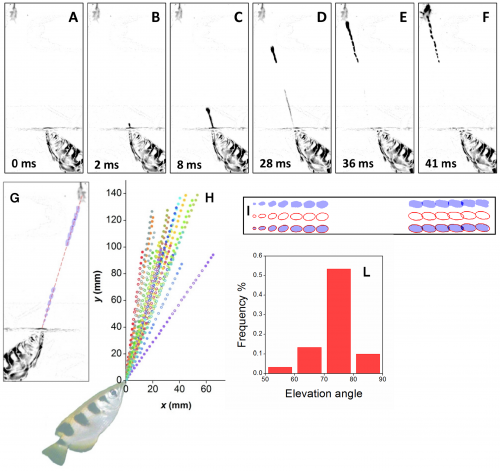December 3, 2013 weblog
Researchers uncover amazing physics feat of spitting Archerfish

(Phys.org) —Alberto Vailati and colleagues at the University of Milan have uncovered a truly astonishing feat of physics used by spitting Archerfish to catch prey. Vailati et al report in a paper they've had published in the journal PLoS ONE, that the fish actually cause a mouthful of water they expel, to speed up, as it travels through the air on its way to its target.
Watching Archerfish in action, most would likely be impressed at the way they catch their food. They move to just below the surface then shoot a mouthful of water into the air. The water eventually reaches an insect perched on a branch or blade of grass and knocks it into the water. As the water is inflight, the fish is already on the move, positioning itself to where it knows the insect will land. Then it eats it.
Vailati and his colleagues can't explain how the fish is able to calculate the proper trajectory of its water blob, or how it knows when and where to position itself, but they are able to explain why the water expulsion technique the fish uses, is so successful. It comes down to principles of Physics.
To start things off the researchers filmed the fish—slowing down the action to see what was happening. They discovered what seemed impossible—that the water was actually accelerating as it headed towards its target. Further investigation revealed how it was possible.
First off, the fish pushes the water out harder the longer its spurt lasts. This means that the water at the tail end of the blob of water is moving faster than the water at the leading end. That would normally mean the water blob would flatten as it ran into itself and spread out. Not in this case, instead the fish uses a known fluid dynamics property called the Plateau–Rayleigh instability. This is where water moving as a stream brakes down into small pieces—small segments form and are eventually pinched off to create entirely separate, much smaller blobs, of liquid, all moving in the same direction as the original stream. So, because the tiny blobs are separated, the original blob doesn't bunch up as it travels. But, then it does, as the tiny blobs in back catch up with the ones in front, just before it hits the targeted insect, knocking it, violently off its perch and into the water below.
All in all, it's an amazing use of math and physics—all by a fish with barely any brains.
More information: Vailati A, Zinnato L, Cerbino R (2012) How Archer Fish Achieve a Powerful Impact: Hydrodynamic Instability of a Pulsed Jet in Toxotes jaculatrix. PLoS ONE 7(10): e47867. DOI: 10.1371/journal.pone.0047867
Abstract
Archer fish knock down insects anchored to vegetation by hitting them with a precisely aimed jet of water. The striking force of the jet at the impact is such to overcome the strong anchoring forces of insects. The origin of the effectiveness of such hunting mechanism has been long searched for inside of the fish, in the unsuccessful attempt to identify internal structures dedicated to the amplification of muscular power. Here we perform a kinematic analysis of the jet emitted by two specimens of Toxotes jaculatrix. We estimate that at the impact the jet conveys a typical specific power of about 3000 W/kg, which is well above the maximum specific power of the order of 500 W/kg deliverable by a vertebrate muscle. Unexpectedly, we find that the amplification of muscular power occurs outside of the fish, and is due to a hydrodynamic instability of the jet akin to those occurring in Drop-on-Demand inkjet printing. The investigated fish are found to modulate the velocity of the jet at the orifice to favor the formation of a single, large, water drop that hits the prey abruptly with a large momentum. The observed mechanism represents a remarkable example of use of an external hydrodynamic lever that does possibly not entail the high evolutionary cost needed for the development of highly specialized internal structures dedicated to the storing of mechanical energy.
via Wired
Journal information: PLoS ONE
© 2013 Phys.org



















